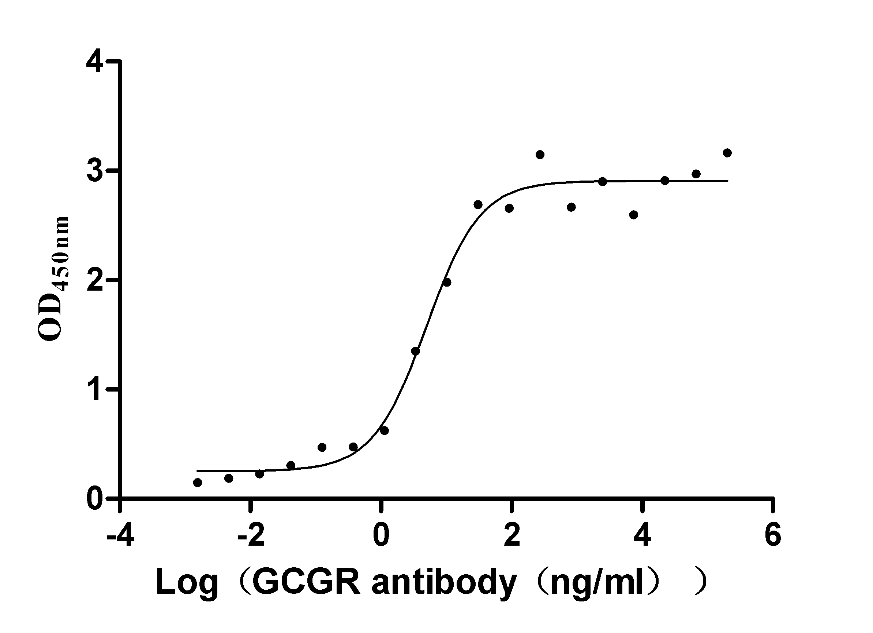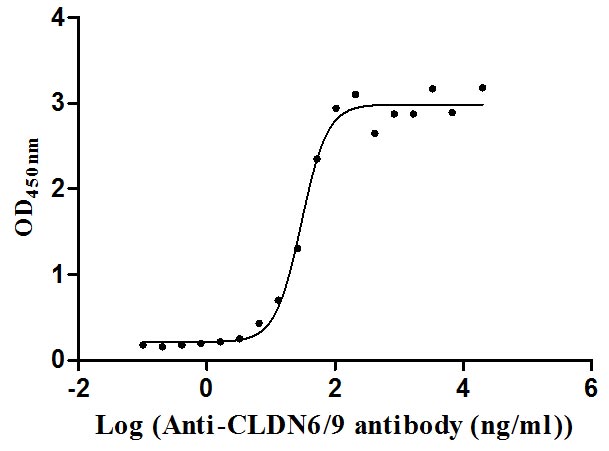Recombinant Mouse Sphingosine 1-phosphate receptor 1 (S1pr1), partial
-
中文名稱:小鼠S1pr1重組蛋白
-
貨號:CSB-YP020650MO1
-
規格:
-
來源:Yeast
-
其他:
-
中文名稱:小鼠S1pr1重組蛋白
-
貨號:CSB-EP020650MO1
-
規格:
-
來源:E.coli
-
其他:
-
中文名稱:小鼠S1pr1重組蛋白
-
貨號:CSB-EP020650MO1-B
-
規格:
-
來源:E.coli
-
共軛:Avi-tag Biotinylated
E. coli biotin ligase (BirA) is highly specific in covalently attaching biotin to the 15 amino acid AviTag peptide. This recombinant protein was biotinylated in vivo by AviTag-BirA technology, which method is BriA catalyzes amide linkage between the biotin and the specific lysine of the AviTag.
-
其他:
-
中文名稱:小鼠S1pr1重組蛋白
-
貨號:CSB-BP020650MO1
-
規格:
-
來源:Baculovirus
-
其他:
-
中文名稱:小鼠S1pr1重組蛋白
-
貨號:CSB-MP020650MO1
-
規格:
-
來源:Mammalian cell
-
其他:
產品詳情
-
純度:>85% (SDS-PAGE)
-
基因名:
-
Uniprot No.:
-
別名:S1pr1; Edg1; Lpb1; Sphingosine 1-phosphate receptor 1; S1P receptor 1; S1P1; Endothelial differentiation G-protein coupled receptor 1; Lysophospholipid receptor B1; Sphingosine 1-phosphate receptor Edg-1; S1P receptor Edg-1; CD antigen CD363
-
種屬:Mus musculus (Mouse)
-
蛋白長度:partial
-
蛋白標簽:Tag?type?will?be?determined?during?the?manufacturing?process.
The tag type will be determined during production process. If you have specified tag type, please tell us and we will develop the specified tag preferentially. -
產品提供形式:Lyophilized powder
Note: We will preferentially ship the format that we have in stock, however, if you have any special requirement for the format, please remark your requirement when placing the order, we will prepare according to your demand. -
復溶:We recommend that this vial be briefly centrifuged prior to opening to bring the contents to the bottom. Please reconstitute protein in deionized sterile water to a concentration of 0.1-1.0 mg/mL.We recommend to add 5-50% of glycerol (final concentration) and aliquot for long-term storage at -20℃/-80℃. Our default final concentration of glycerol is 50%. Customers could use it as reference.
-
儲存條件:Store at -20°C/-80°C upon receipt, aliquoting is necessary for mutiple use. Avoid repeated freeze-thaw cycles.
-
保質期:The shelf life is related to many factors, storage state, buffer ingredients, storage temperature and the stability of the protein itself.
Generally, the shelf life of liquid form is 6 months at -20°C/-80°C. The shelf life of lyophilized form is 12 months at -20°C/-80°C. -
貨期:Delivery time may differ from different purchasing way or location, please kindly consult your local distributors for specific delivery time.Note: All of our proteins are default shipped with normal blue ice packs, if you request to ship with dry ice, please communicate with us in advance and extra fees will be charged.
-
注意事項:Repeated freezing and thawing is not recommended. Store working aliquots at 4°C for up to one week.
-
Datasheet :Please contact us to get it.
相關產品
靶點詳情
-
功能:G-protein coupled receptor for the bioactive lysosphingolipid sphingosine 1-phosphate (S1P) that seems to be coupled to the G(i) subclass of heteromeric G proteins. Signaling leads to the activation of RAC1, SRC, PTK2/FAK1 and MAP kinases. Plays an important role in cell migration, probably via its role in the reorganization of the actin cytoskeleton and the formation of lamellipodia in response to stimuli that increase the activity of the sphingosine kinase SPHK1. Required for normal chemotaxis toward sphingosine 1-phosphate. Required for normal embryonic heart development and normal cardiac morphogenesis. Plays an important role in the regulation of sprouting angiogenesis and vascular maturation. Inhibits sprouting angiogenesis to prevent excessive sprouting during blood vessel development. Required for normal egress of mature T-cells from the thymus into the blood stream and into peripheral lymphoid organs. Plays a role in the migration of osteoclast precursor cells, the regulation of bone mineralization and bone homeostasis. Plays a role in responses to oxidized 1-palmitoyl-2-arachidonoyl-sn-glycero-3-phosphocholine by pulmonary endothelial cells and in the protection against ventilator-induced lung injury.
-
基因功能參考文獻:
- S1P1 deletion in cardiac hemo-vascular precursor cells leads to ventricular non-compaction cardiomyopathy. PMID: 28338096
- apoM-S1P-S1PR1 signaling might underlie the pathogenesis of ALI and apoM could have physiological benefits to alleviate LPS-induced ALI. PMID: 29260347
- analysis of dynamics and spatial specificity of S1P1 activation in a mouse model PMID: 29079828
- our results indicate that the modulation of S1P1 expression and S1P/S1P1 interactions in NOD mouse thymocytes are part of the T-cell migratory disorder observed during the pathogenesis of type 1 diabetes. PMID: 29757216
- Study identifies functional antagonism of S1PR1 as a major mechanism for the protective effect of FTY720 in the cuprizone model and suggests pathogenic contributions of astrocyte S1PR1 signaling in primary demyelination and its potential as a therapeutic target for CNS inflammation. PMID: 29193293
- Collectively, these results suggest that S1PR1 acts as a major regulator of retinal neuron survival and restricts the retinal ganglion cell growth response induced by CNTF. PMID: 29234527
- Our data suggests that sphingosine-1-phosphate receptor 1 in macrophages plays an important role in protecting them against apoptosis in vitro and in atherosclerotic plaques in vivo, and delays diet induced atherosclerosis development in Ldlr deficient mice PMID: 29244772
- These data suggest that brain endothelial S1P1 maintain the BBB by regulating the proper localization of tight junction proteins and raise the possibility that endothelial S1P1 inhibition may be a strategy for transient BBB opening and delivery of small molecules into the CNS. PMID: 28396408
- Astrocytic S1PR controls astrocyte neurotoxicity and monocyte recruitment and activation. PMID: 28167760
- Tonic S1P1 signaling by endogenous sphingosine-1-phosphate contributes to intracellular Ca(2+) homeostasis by maintaining basal Na+/H+ exchanger-1 activity and controls simultaneously myofibril Ca(2+) sensitivity through its inhibitory effect on adenylate cyclase. PMID: 27207969
- these data demonstrate that chronic inflammation modulates S1P1 expression and tissue S1P levels PMID: 27049060
- promotes lymphangiogenesis and metastasis via NLRP3/IL-1beta in tumor-associated macrophages PMID: 28739604
- The study suggests that vascular leakage of albumin-sized particles in ApoM deficiency is S1P- and S1P1-dependent and this dependency exacerbates the response to inflammatory stimuli. PMID: 26956418
- The present results suggest that Fas/S1P1 signaling via activation of NF-kappaB in osteoclast precursor cells is a key factor in the pathogenesis of rheumatoid arthritis in the temporomandibular joint. PMID: 28687489
- Activation of the S1P1 receptor in cardiac mast cells confers cardio-protection during cardiac mast cell degranulation. PMID: 28500264
- this study shows that S1P1 downregulation mirrors the strength and persistence of the TCR stimulation, limiting egress of high affinity T cells from lymph nodes PMID: 27730626
- After axonal damage, S1PR1 expression was decreased in retinal neurons PMID: 27309795
- These results indicate a role for S1P signaling in Bordetella pertussis-mediated pathology. PMID: 27815382
- These results suggest that S1P signaling via S1P1 in cardiomyocytes plays a previously unknown and necessary role in heart development in mice in expansion of cardiomyocyte number and ventricular compaction. PMID: 27333774
- Profound depletion of S1p renders both erythrocyte and platelet pools necessary for recovery during anaphylactic shock. PMID: 27582371
- S1P induced chemotaxis in M1 macrophages and changed cytokine production in M2 macrophages. Phagocytosis was not affected by S1P-signalling. PMID: 28367448
- Data indicate that forkhead box F1 (Foxf1) deletion from endothelial cells decreases the abundance of sphingosine 1-phosphate receptor 1 (S1PR1). PMID: 27095594
- Study provided evidence for a role of S1P1 in regulating oligodendrocyte differentiation and developmental myelination PMID: 26662919
- S1P is localized in the presynaptic regions of mature neurons and is regulated by sphingosine-1-phosphate. PMID: 27098703
- S1P1 receptor-selective up-regulation reduces the severity of acute graft versus host disease by inhibiting macrophage recruitment. PMID: 25088224
- Early after VSV infection, WT and S1PR1(-/-) effector T cells localized exclusively within the lymph node paracortex. However, in contrast to WT, S1PR1(-/-) effector T cells failed to enter the sinuses. PMID: 26862175
- GPER and Gankyrin might be implicated in the hormonal regulation of endometriosis and be associated with the severity of endometriosis. PMID: 26193952
- Sphingosine-1-Phosphate Receptor-1 Selective Agonist Enhances Collateral Growth and Protects against Subsequent Stroke. PMID: 26367258
- the ability of ApoM(+)HDL to act as a biased agonist on S1P1 inhibits vascular inflammation, which may partially explain the cardiovascular protective functions of HDL. PMID: 26268607
- Autocrine action of S1P in DJ-1 knock-out mice vascular smooth muscle cells results from the up-regulation of SPT2. PMID: 25978603
- S1P1 had a significant effect in corneal allograft rejection inhibition. PMID: 25607596
- The role of sphingosine-1-phosphate in the production of immature double-negative thymocytes in experimental and chronic Chagas disease is reported. PMID: 25330249
- The neuronal sphingosine-1-phosphate/S1PR1/STAT3 signalling axis plays a critical role in the control of energy homeostasis. PMID: 25255053
- Sphingosine-1-phosphate receptor 1 (S1PR1) was found as a new target gene of miR-155 by in vitro and in vivo studies; its expression was decreased in SLE patients and Fas(lpr/lpr) mice. PMID: 25911753
- S1P sensitizes ICAPS through G-protein coupled S1P1 receptor activation of Galphai-PI3K-PKC-p38 signaling pathway in sensory neurons PMID: 25431213
- protective role for endothelial S1P1R against ischemic acute kidney injury most likely by regulating endothelial barrier integrity and endothelial HSP27 expression PMID: 24025642
- Findings suggest that sphingosine phosphate lyase (S1P lyase) expressed in the thymic medullary perivascular spaces keeps the tissue sphingosine 1-phosphate low around the vessels and promotes thymic egress via up-regulation of S1P receptor 1 (S1P1). PMID: 24343820
- A novel role for moesin in regulating clathrin-dependent S1PR1 internalization through clathrin-coated vesicles formation. PMID: 24358210
- Regulation of endothelial S1PR1 dynamically controls vascular integrity and maturation and thus modulates angiogenesis, tumor growth, and hematogenous metastasis. PMID: 24740542
- S1PR1 mRNA was ubiquitously expressed in all the tissues examined, and significant differences were seen in mRNA expression between H9N2 virus infected and control mice in detected tissues. PMID: 24073762
- Sphingosine-1-phosphate receptor 1 reporter mice reveal receptor activation sites in vivo PMID: 24667638
- Data suggest that the sphingosine-1-phosphate receptor S1P1-mTOR signaling axis as a potential therapeutic target in hepatic injury. PMID: 24567529
- S1PR1 expression on macrophages might, therefore, be relevant for restoring tissue homeostasis during the resolution of inflammation. PMID: 23934754
- Results suggest that S1P (sphingosine 1-phosphate) induces endothelium-dependent vasorelaxation mainly through S1P(1) receptor and involves PAR-2 (proteinase activated receptor-2) transactivation. PMID: 24131465
- key role of Sphk1, S1PR1 and S1PR3 in angiogenesis underlying the liver fibrosis process PMID: 23466305
- Data indicate taht regulation of KLF2 and S1P1 (S1pr1) provides a switch that dictates whether CD8(+) T cells commit to recirculating or tissue-resident memory populations. PMID: 24162775
- Impaired S1P1 phosphorylation enhances TH17 polarization and exacerbates autoimmune neuroinflammation. PMID: 24076635
- We demonstrate that restoration of cardiac plasma membrane levels of S1PR1 produces beneficial effects that counterbalance the deleterious beta1AR overstimulation in heart failure. PMID: 23969695
- Activation of S1P receptor signaling pathways using KRP-203 inhibits atherosclerosis in LDLR knockout mice. PMID: 23640484
- A brief treatment with S1PR1 modulator KRP203 significantly prolonged islet allograft survival, whereas additional intragraft delivery of Tregs induced tolerogenic effects selective to islet alloantigens. PMID: 23545505
顯示更多
收起更多
-
亞細胞定位:Cell membrane; Multi-pass membrane protein. Endosome. Membrane, caveola.
-
蛋白家族:G-protein coupled receptor 1 family
-
組織特異性:Expressed in a wide variety of tissues with highest levels in brain, heart and spleen. Lower levels found in kidney, liver, lung, muscle, placenta, thymus, and uterus. Very low levels in intestine, stomach and testis. According to PubMed:9931453, expresse
-
數據庫鏈接:
Most popular with customers
-
Recombinant Human Glucagon receptor (GCGR), partial (Active)
Express system: Mammalian cell
Species: Homo sapiens (Human)
-
Recombinant Human Claudin-9 (CLDN9)-VLPs (Active)
Express system: Mammalian cell
Species: Homo sapiens (Human)













